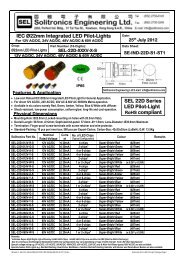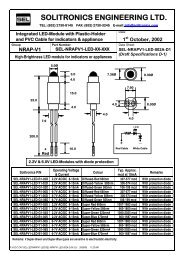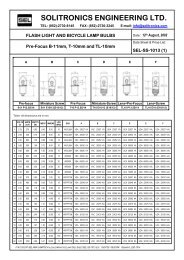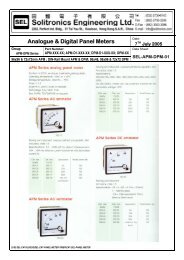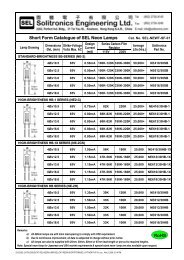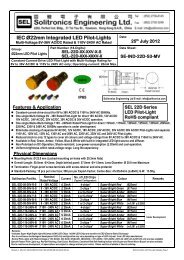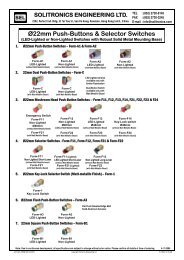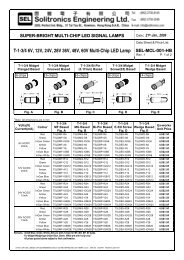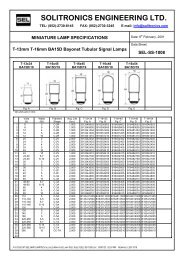16mm Push-Button Switch - Solitronics
16mm Push-Button Switch - Solitronics
16mm Push-Button Switch - Solitronics
- No tags were found...
Create successful ePaper yourself
Turn your PDF publications into a flip-book with our unique Google optimized e-Paper software.
SOLITRONICS ENGINEERING LTD.2202, Perfect Industrial Bldg. 31, Tai Yau St. San Po Kong, Kowloon, Hong KongTEL : (852) 2730-8145FAX : (852) 2730-3245E-mail : info@solitronics.comØ<strong>16mm</strong> <strong>Push</strong>-<strong>Button</strong>s & Indicators1. Ø<strong>16mm</strong><strong>Push</strong>-<strong>Button</strong> <strong>Switch</strong> (LED-Lighted and Non-Lighted)F1=18x24mm F2=18x24mm F3=Ø18mm2. Ø<strong>16mm</strong> LED Pilot LightF1=18x24mm F2=18x24mm F3=Ø18mm3. Ø<strong>16mm</strong> Mushroom <strong>Push</strong>-<strong>Button</strong> <strong>Switch</strong>es (LED-Lighted and Non-Lighted)F1=18x24mm F2=18x24mm F3=Ø18mm4. Ø<strong>16mm</strong> Panel Mount BuzzersF1=18x24mm F2=18x24mm F3=Ø18mm5. Ø<strong>16mm</strong> Selector <strong>Switch</strong>es (LED-Lighted and Non-Lighted)F1=18x24mm F2=18x24mm F3=Ø18mm6. Ø<strong>16mm</strong> Key-Lock SelectorsF1=18x24mm F2=18x24mm F3=Ø18mm7. AccessoriesAccessories and spare parts and mounting tools etc. for our <strong>16mm</strong> range of <strong>Push</strong>-button switches are also available.Contact us for accessory, spare part and mounting tool catalogue.<strong>Solitronics</strong> Engineering Ltd SEL-PBSW+IND-Cover 11/13/2009 4:51 PM
• External events affect the driver’s operation (dynamic topology changes,network traffic, hardware failures, etc).• The Class Driver optimizes the 1394 protocol’s operating parametersdepending on the physical topology of the network.• High performance is a crucial aspect (400 Mbps data rate). This requiresmaximizing concurrency and minimum interdependencies, which leads tocomplex program code.Additionally, most product specifications are related to more than onefunction, making the integration and system testing a complicated process.Considering this situation, the software testing team decided to apply the ANSI/IEEEStandard [5,6] as a framework for testing the product.According to this standard the test case construction is based on thecharacteristics of a unit or a group of units, where a unit can be a function or a groupof functions. These directives assist the testers to generate and document many testcases for the test requirements generated by the product’s special characteristics.Heuristics were developed to derive test cases from the test requirements. Tools wereused to support the testing process, either for documentation or for observing theexpected or unexpected (memory leaking) results. Additionally ‘test drivers’ wereconstructed to facilitate the test procedure by automating batch test execution.This testing approach became a guidebook for the designation of many testcases. Approximately 250 bugs were detected by testing the functions of theuser-mode API layer, the majority of which were attributed to the Class Driver.However, in some cases the problems were caused by shortcomings in the user-modecode. The final result was the construction of a product that appears to be highlyreliable, judging from the relatively small number of bugs (40) that have been foundby the customers during its usage for over a year.The organization of the paper is as follows. The basic definitions related witha communications driver are introduced in the next section. Section 2 introduces thebasic principles of the IEEE 1394-1995 standard. Section 3 presents the specialcharacteristics of the API library. Section 4 describes the framework used in testingand section 5 presents the problems encountered therein. In section 6, the results oftesting the communications driver are discussed. Section 7 designates benefits andlearning objectives and finally the concluding remarks are outlined in section 8.2. The IEEE 1394 High Speed Serial Bus StandardIEEE 1394 is a high-speed serial bus interface standard, which combines themultimedia consumer, the computing and the industry area. At the end of the 80’sApple developed the high-speed data transmission system and trademarked it as“FireWire”. In 1995 the IEEE (Institute of Electrical and Electronic Engineers)standardized the high performance serial bus [7].Today many electronic devices, including computers, printers, digital cameras,camcorders, monitors, VCRs, scanners, HDDs and other storage media, can beinterconnected on the same local network and communicate using this technology.IEEE 1394 is a universal interconnect solution that has been designed to bringtogether a variety of peripherals and consumer devices on the same network. Thecurrent implementations support data rates of 100, 200 and 400Mbps, and the- 3 -



